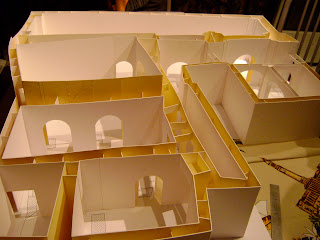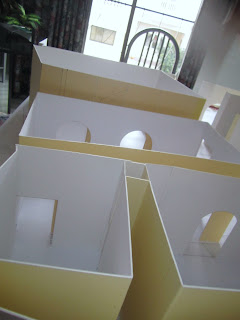We agreed that something interactive with the viewer would give an experience. We noticed that the artifacts exhibited in the museum lost their value of appreciation when seen standing solo knowing that originally this stone formed part of a temple, so we came up with the idea to "rebuild" the temple using these artifacts in their original place. We did not want to replicate what there is in Mnajdra as it is pointless so we gave the temple a contemporary design mixed with the ancient original stones.
This is the technique we would be using to rebuild the temples using plywood. at first we weren't thinking of putting spacers between each layer but decided otherwise as it gives the design a sense of depth in the structure.
This technique will also be used around the walls found in the museum creating display stands between layers.
First concept of temple using layers without spacers in between ( using 3D studio max):
Sketch showing how the walls will be connecting to the temple and the original artifact placed between the layers:
Test piece of differently shaped layers done with foam board:
Sketch of walls covered with layers:
Sketch of artifacts displayed between layers:
CAD drawings of display stands between layers:
Model of temple made out of watercolour drawing paper for the layers and foam board for the spacers:
We also came up with the idea of exhibiting the small exhibits separately to attract interest to the viewer because as they are currently displayed one can see all of them at a glance without appreciating each one separately. We designed perspex boxes coming down from the layered ceiling held by a rod each with a small artifact so that the view can see it from different sides and angles one by one. It also arises the element of surprise what to find in each box.
Each box is of different sizes depending on the artifact.
3D studio Max drawings of concept:
Model of display made out of plastic with artifact inside the box:

























































